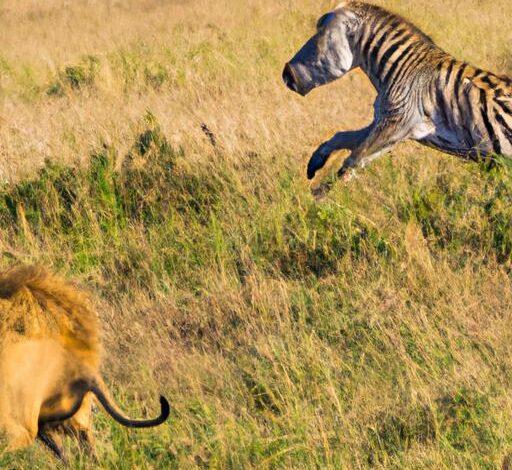What Travels Through a Food Chain: Exploring the Fascinating Journey of Energy

Imagine a world where everything is interconnected, where the energy from one organism flows seamlessly into another. Welcome to the captivating realm of food chains! In this article, we’ll dive into what exactly travels through a food chain and unravel the intricate web of energy transfer that sustains our ecosystems.
Introduction: Unveiling the Essence of a Food Chain
At its core, a food chain is a mechanism that showcases the transfer of energy from one organism to another. It represents the flow of life-sustaining energy through various interconnected organisms, ultimately shaping the delicate balance of nature. In essence, a food chain is like a grand symphony, with each organism playing a unique role in the harmony of life.
Energy transfer lies at the heart of every food chain. It all begins with the primary producers, the foundation of the chain. These remarkable organisms, such as plants or algae, have the extraordinary ability to harness the radiant energy of the sun through the process of photosynthesis. They convert this radiant energy into chemical energy, storing it within their cells. But what happens next?
The energy captured by primary producers sets the stage for the captivating drama that unfolds in a food chain. Enter the primary consumers, the herbivores, who feast upon the primary producers. As these consumers munch on plants or algae, they absorb the stored energy, propelling it through the chain. But the journey doesn’t end here; it continues with the secondary and tertiary consumers, the carnivores or omnivores, who further transfer the energy by consuming other organisms.
Energy Transfer: A Marvelous Journey through the Food Chain
As energy travels through a food chain, it undergoes a remarkable transformation. Picture it as a baton passed from one performer to another in a relay race. With each transfer, a portion of the energy is utilized for the consumer’s growth, movement, and reproduction. Yet, some energy dissipates as heat, fulfilling the laws of thermodynamics.
This captivating journey of energy transfer highlights the dynamic interactions within an ecosystem. It embodies the interconnectedness of organisms, emphasizing the delicate balance required for the survival of all species. As energy flows through the food chain, it shapes the population dynamics, influencing the abundance or scarcity of organisms at each level.
But what about the remaining energy? What happens to it once it reaches the end of the food chain? Join me in the next section as we explore the concept of nutrient cycling and the essential role it plays in sustaining ecosystems.
Stay tuned for Section II: Understanding the Basics of a Food Chain, where we’ll delve deeper into the components and dynamics of this fascinating ecological phenomenon. Get ready to embark on a journey through the intricate web of life, where energy reigns supreme and the survival of ecosystems hangs in the balance.
Understanding the Basics of a Food Chain
The Essence of a Food Chain
A food chain is a captivating ecological concept that showcases the transfer of energy from one organism to another within an ecosystem. It depicts the interconnected relationships between different organisms, highlighting the flow of life-sustaining energy. To grasp the intricacies of a food chain, let’s delve into its fundamental components.
Components of a Food Chain
A food chain consists of three primary components: producers, consumers, and decomposers. Each component plays a crucial role in maintaining the delicate balance of energy flow within an ecosystem.
1. Producers
Producers, also known as autotrophs, are the foundation of every food chain. These remarkable organisms have the ability to produce their own food through photosynthesis or chemosynthesis. Plants, algae, and some bacteria fall into this category. They harness the radiant energy of the sun or certain chemicals to synthesize organic compounds, storing energy within their tissues.
2. Consumers
Consumers, also known as heterotrophs, rely on other organisms for their energy needs. They consume other organisms to obtain the energy and nutrients necessary for their survival. Consumers can be further classified into different levels based on their feeding habits and position in the food chain.
- Primary Consumers: Primary consumers are herbivores that directly feed on producers. They consume plants or algae, harnessing the stored energy within these organisms.
- Secondary Consumers: Secondary consumers are carnivores that feed on primary consumers. They obtain energy by consuming herbivores or other primary consumers.
- Tertiary Consumers: Tertiary consumers are carnivores or omnivores that occupy the highest level in the food chain. They prey on other carnivores or omnivores, obtaining energy from these organisms.
3. Decomposers
Decomposers play a vital role in the food chain by breaking down organic matter from dead organisms and waste materials. They include bacteria, fungi, and certain types of insects. Decomposers release nutrients back into the environment, allowing them to be recycled and utilized by producers once again.
Examples of Organisms in Each Category
In a typical food chain, examples of organisms in each category include:
- Producers: Grass, trees, phytoplankton, and algae.
- Primary Consumers: Rabbits, cows, deer, and insects.
- Secondary Consumers: Snakes, foxes, wolves, and certain birds.
- Tertiary Consumers: Lions, sharks, eagles, and humans (as omnivores).
Understanding the components of a food chain lays the foundation for comprehending the intricate dynamics that drive energy flow within an ecosystem. In the next section, we will explore the mesmerizing journey of energy through a food chain and the significance of nutrient cycling. Brace yourself for a captivating adventure through the interconnected world of nature!
Section III: The Flow of Energy in a Food Chain
Overview: Understanding the Journey of Energy
In the intricate realm of food chains, energy takes center stage, flowing from one organism to another in a captivating dance of survival. Let’s take a closer look at how this energy moves through the chain, shaping the dynamics of ecosystems.
Primary Producers: Capturing Energy from the Sun
At the very beginning of the food chain, we encounter the primary producers. These incredible organisms, such as plants, algae, and some bacteria, possess the unique ability to capture energy from the sun through the process of photosynthesis. They harness the radiant energy and convert it into chemical energy, stored in the form of complex organic compounds like glucose.
As these primary producers utilize the sun’s energy, they become the primary source of energy for all other organisms in the food chain. They are the foundation upon which the entire ecosystem is built, providing sustenance for the rest of the community.
Primary Consumers: The Hungry Herbivores
Continuing our journey through the food chain, we encounter the primary consumers, also known as herbivores. These fascinating creatures feed exclusively on the primary producers, consuming plants or algae. By doing so, they absorb the stored energy within the producers’ tissues, effectively transferring it to the next level of the chain.
The primary consumers play a crucial role in energy transfer, acting as intermediaries between the primary producers and the higher-level consumers. They ensure the flow of energy and maintain the balance within the ecosystem.
Secondary and Tertiary Consumers: The Predatory Players
Moving further up the food chain, we encounter the secondary and tertiary consumers, the carnivores and omnivores. These opportunistic predators feed on other organisms, including both primary consumers and even other secondary consumers.
These higher-level consumers have a significant impact on energy transfer. By preying on other organisms, they not only obtain energy for their own survival but also control the population dynamics of the lower trophic levels. They act as regulators, ensuring the balance within the food chain and maintaining the stability of the ecosystem.
Conclusion of Section III
As we delve deeper into the flow of energy within a food chain, we witness the intricate dynamics that sustain life in ecosystems. From the primary producers capturing the sun’s energy to the primary consumers transferring it further, and finally, the secondary and tertiary consumers shaping the chain’s balance, every level plays a vital role.
Stay tuned for the upcoming sections where we will explore the fascinating concept of nutrient cycling and the various factors that influence the stability and functioning of food chains. Prepare to be amazed as we unravel the secrets of these interconnected webs of life!
Nutrient Cycling in a Food Chain
As we explore the intricate dynamics of a food chain, it becomes evident that energy isn’t the only crucial factor at play. Nutrient cycling, a fundamental process within ecosystems, ensures the sustainability and balance necessary for life to thrive. Let’s delve deeper into the fascinating world of nutrient cycling and its vital role in the food chain.
How Nutrients Are Recycled Within a Food Chain
Nutrient cycling involves the continuous movement and transformation of essential elements, such as carbon, nitrogen, and phosphorus, through various organisms and the environment. It ensures the availability of these nutrients for primary producers, completing the cycle of life. But how does this intricate process unfold?
At the heart of nutrient cycling are decomposers, nature’s unsung heroes. These organisms, including bacteria and fungi, break down dead organic matter, returning valuable nutrients to the environment. As decomposers feast on decaying plants, animals, and waste, they release essential elements trapped within these organic materials. These nutrients, once liberated, become available for uptake by primary producers, initiating a new cycle of growth and energy transfer.
The Role of Decomposers in Nutrient Cycling
Decomposers play a crucial role in the food chain by breaking down complex organic matter into simpler forms. Through their enzymatic activities, they convert dead organisms and waste into smaller molecules, such as carbon dioxide, water, and inorganic nutrients. This breakdown process not only releases energy but also liberates essential elements that were once locked within organic compounds.
Furthermore, decomposers contribute to the stabilization of ecosystems by preventing the accumulation of organic waste. Without their relentless efforts, the environment would be overwhelmed by decaying matter, leading to a decline in ecosystem health and productivity. Through their vital role in nutrient cycling, decomposers ensure the efficient recycling of resources, maintaining the delicate balance necessary for the survival of all organisms within the food chain.
Nutrient Cycling: Ensuring Ecosystem Sustainability
Nutrient cycling is crucial for the sustainability of ecosystems. It allows for the replenishment of essential elements required by primary producers for growth and survival. By recycling nutrients, the food chain can support a diverse array of organisms, each playing their part in maintaining ecological balance.
Moreover, nutrient cycling mitigates the loss of valuable resources from the ecosystem. It minimizes the need for external inputs and reduces the reliance on finite resources, promoting ecological resilience and reducing environmental impacts. This intricate process exemplifies nature’s efficiency, where nothing goes to waste, and every component serves a purpose in sustaining the intricate tapestry of life.
In the next section, we’ll explore the various factors that influence the stability and functioning of a food chain. Join me as we unravel the complexities of this delicate web and understand the impacts of human activities, climate change, and habitat loss on the intricate balance of nature.
Factors Influencing the Food Chain
The delicate balance of a food chain can be easily disrupted by a multitude of factors. In this section, we will explore the various elements that can impact the stability and functioning of food chains, and delve into the consequences of their disturbance.
The Fragile Equilibrium: Factors at Play
A food chain is an intricate web, finely tuned to maintain equilibrium. Any disturbance to this delicate balance can have far-reaching consequences. Let’s examine some of the key factors that influence the stability and functioning of a food chain.
1. Human Activities: A Double-Edged Sword
Human activities can significantly impact food chains. The expansion of agriculture, deforestation, and pollution all contribute to habitat destruction, ultimately disrupting ecosystems. As we encroach upon natural habitats, we often alter the availability of resources for organisms within the food chain. This can lead to the decline or extinction of certain species, causing a ripple effect throughout the entire chain.
2. Climate Change: Nature’s Unpredictable Force
Climate change poses a significant threat to food chains worldwide. Rising temperatures, changing precipitation patterns, and extreme weather events directly affect the distribution and abundance of organisms. Species that are unable to adapt quickly enough may struggle to find sufficient food sources or suitable habitats. This disruption can cascade through the food chain, impacting multiple levels of consumers and ultimately threatening the stability of entire ecosystems.
Disrupted Food Chains: Unraveling the Consequences
The consequences of disrupted food chains are far-reaching and can have devastating effects on ecosystems. Let’s explore some examples to understand the gravity of these disruptions.
1. Loss of Keystone Species
Keystone species play a vital role in maintaining the balance of a food chain. Their presence has a disproportionate impact on the structure and diversity of ecosystems. When keystone species are lost due to human activities or environmental changes, it can trigger a domino effect. The absence of these crucial organisms can lead to an overabundance of certain species or the proliferation of invasive species, disrupting the natural dynamics of the food chain.
2. Trophic Cascades
Trophic cascades occur when a change in one trophic level, such as a decline in predators, has a ripple effect throughout the food chain. For instance, the removal of top predators can cause an increase in the population of their prey, which in turn may lead to a decline in the primary producers. This disruption impacts the entire ecosystem, altering species interactions and potentially leading to a loss of biodiversity.
In conclusion, human activities, climate change, and habitat loss pose significant threats to the stability and functioning of food chains. Understanding the impact of these factors is crucial for mitigating their effects and preserving the intricate interconnectedness of our ecosystems. Join me in the next section as we wrap up our exploration and reflect on the importance of comprehending what travels through a food chain.
Conclusion: Nurturing the Delicate Balance of Food Chains
As we reach the end of our exploration into the wonders of food chains, we are reminded of the crucial role they play in maintaining the delicate balance of ecosystems. The journey of energy through a food chain is nothing short of remarkable, showcasing the interconnectedness and interdependence of all living organisms.
By understanding what travels through a food chain, we gain insight into the intricate mechanisms that sustain life on our planet. Primary producers harness the sun’s energy, which is then passed on to primary consumers, secondary consumers, and beyond. This energy transfer shapes the population dynamics and influences the overall health and stability of ecosystems.
However, the journey of energy doesn’t end at the top of the food chain. It continues its cycle through the process of nutrient cycling. Decomposers break down organic matter, returning essential nutrients to the environment, completing the circle of life and ensuring the sustainability of ecosystems.
Sadly, human activities, climate change, and habitat loss pose significant threats to food chains. Disruptions in these chains can have far-reaching consequences, leading to imbalances and the potential collapse of entire ecosystems. It is our responsibility to protect and preserve these delicate systems, fostering a harmonious coexistence with nature.
In conclusion, food chains are not just abstract concepts but the lifeblood of our planet. They exemplify the remarkable journey of energy and the interconnectedness of all living organisms. By appreciating and safeguarding these intricate webs, we can ensure a vibrant and sustainable future for generations to come.
So, let us embrace the wonders of food chains and recognize our role in nurturing the delicate balance of nature. Together, we can embark on a journey of understanding, appreciation, and preservation, ensuring that the energy continues to flow, and the harmony of life thrives in every corner of our magnificent planet.
Conclusion: So above is the What Travels Through a Food Chain: Exploring the Fascinating Journey of Energy article. Hopefully with this article you can help you in life, always follow and read our good articles on the website: Game Zone


